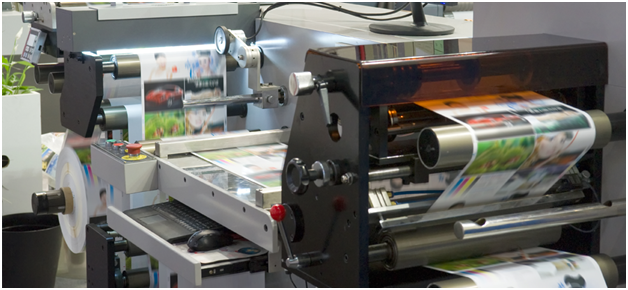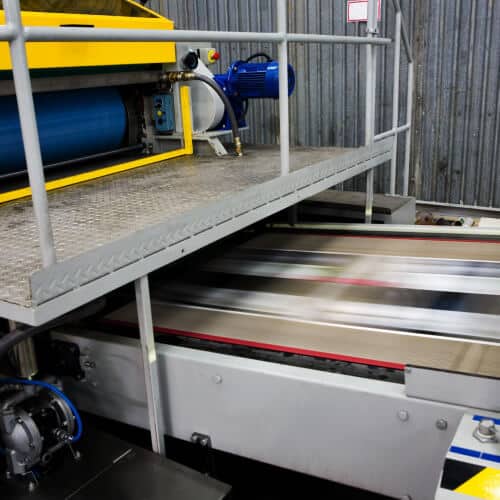The Essential Guide to Recognizing Litho Printing and Its Applications
Litho printing stands as a significant technique in the printing market, rooted in the principles of oil and water repulsion. This strategy not just supplies top notch pictures yet likewise accommodates different industrial needs. Its applications vary from advertising and marketing materials to packaging, showcasing its flexibility. As the sector adapts to new innovations, the advancement of litho printing questions about its future and relevance in a digital landscape. What lies in advance for this sustaining method?

What Is Litho Printing?
Litho printing, an extensively used printing technique, relies upon the principle of oil and water repulsion. This approach uses a flat printing surface, generally a steel plate, which is dealt with to assure that the photo locations are receptive to oil-based inks while the non-image areas repel them. The process begins with the creation of an image on the plate, typically through drawing or photo methods. When the picture is prepared, the plate is dampened with water, followed by the application of ink. The ink sticks only to the image areas, permitting for specific recreation of graphics and text. Litho printing is preferred for its capacity to create top notch prints with fine detail and vivid shades. It is frequently used in commercial applications, consisting of papers, magazines, and product packaging, showcasing its adaptability and performance in fulfilling the demands of modern-day printing.
The Background of Lithography
Lithography is a contemporary printing staple, its origins map back to the late 18th century when German playwright Alois Senefelder developed the technique in 1796. Originally established as an approach for replicating texts and images, lithography made use of a flat rock surface to produce prints with a chemical process. Senefelder's development enabled higher flexibility and imaginative expression compared to previous printing methods.By the 19th century, lithography got widespread acceptance, coming to be a popular option amongst artists and publishers. It made it possible for the mass production of pictures, maps, and posters, especially impacting the printing market. The strategy further developed with the intro of lithographic presses, enhancing effectiveness and quality.As the commercial change progressed, lithography adapted to satisfy the needs of business printing, paving the method for contemporary applications. Today, it stays an essential method in numerous industries, including posting, packaging, and art reproduction.
Just How Litho Printing Functions
A key feature of litho printing is its reliance on the concept of oil and water repulsion - litho printing. In this process, pictures are moved from a level surface, commonly a metal or polymer plate, to paper. The plate is dealt with so that the areas planned for printing bring in ink, while the non-image areas repel it due to their affinity for water. The printing begins by moistening the plate with water, which adheres to the non-image areas. Subsequently, an oil-based ink is applied, sticking only to the intended image areas.When home plate enters into call with the substratum, the ink is moved, producing a print. The litho printing procedure can producing premium pictures with fine detail. It is frequently utilized for mass production due to its efficiency and uniformity, making it a recommended technique for industrial printing applications
Advantages of Litho Printing
One noteworthy benefit of litho printing is its capacity to create premium images continually, making it an optimal choice for business tasks. This printing technique uses a level printing plate, ensuring even ink circulation and sharp details. Litho printing is also renowned for its color precision, allowing vibrant and true-to-life reproductions, which is essential for branding materials.Moreover, it sustains a wide range of substrates, consisting of paper, cardboard, and even specific plastics, boosting its flexibility. The procedure is affordable for huge runs, as economies of scale lower per-unit costs. In enhancement, litho printing has a fast turnaround time, permitting efficient production schedules.Its longevity also indicates that published materials stand up to fading, ensuring that the final item keeps its visual charm with time. Overall, these advantages make litho publishing a recommended choice throughout various markets, adding to its long-lasting appeal.
Applications of Litho Printing in Business
As services significantly look for dependable and top notch printing solutions, litho printing emerges as a principal in different applications. This strategy is specifically preferred for producing marketing materials such as pamphlets, leaflets, and directories, many thanks you could look here to its capacity to supply vivid shades and sharp images. Furthermore, litho printing is regularly used for product packaging solutions, allowing companies to create appealing labels and boxes that enhance product appeal.In the industry of corporate identification, litho printing is critical in generating specialist stationery, calling card, and promotional product, which assist strengthen brand name acknowledgment. In addition, it is extensively made use of in the posting market for printed products such as publications and publications, where constant quality is vital. On the whole, litho printing's flexibility and efficiency make it an important device for organizations aiming to communicate properly and establish a strong market visibility.
Artistic Use Litho Printing
Litho printing functions as a functional medium in the domain name of printmaking, offering musicians a distinct approach to reveal their creativity. This strategy permits a wide variety of artistic applications, from conventional prints to contemporary interpretations. By discovering the nuances of litho printing, musicians can harness its unique top qualities to improve their job.

Printmaking Strategies Introduction
The virtuosity of printmaking includes a varied series of methods, with litho printing standing out for its distinct strategy to image development. This method depends on the principle of oil and water repulsion, permitting musicians to draw straight onto a limestone or metal plate with an oily tool. When prepared, home plate is dampened and inked, transferring the photo onto paper through stress. Litho printing is commemorated for its capacity to create great information and abundant tonal variants, Click Here making it a favored option amongst musicians. In addition, the process is versatile, fitting both typical techniques and modern adaptations. This versatility permits litho printing to bridge various imaginative designs, enhancing the printmaking landscape with its distinctive features and capacities.
One-of-a-kind Artistic Applications
Checking out the distinct imaginative applications of litho printing reveals its amazing convenience in numerous innovative fields. Musicians use litho printing to develop complex styles and appearances, enabling expressive and thorough jobs. The process assists in the reproduction of vibrant shades, making it perfect for images and art prints. Many modern artists welcome lithography for its capability to combine traditional methods with modern ideas, resulting in ingenious artwork. In addition, litho printing is often employed in the manufacturing of limited edition prints, enhancing their value and charm. The tactile high quality of litho prints includes an unique measurement, drawing in collectors and art lovers alike. Overall, litho printing stays a significant tool for imaginative expression, connecting traditional approaches with modern creativity.
The Future of Litho Printing in a Digital World
As the printing industry evolves, litho printing encounters the challenge of incorporating digital technologies to continue to be appropriate. Methods concentrated on digital integration, along with fads in sustainability and advancement, will shape its future - litho printing. Comprehending these characteristics is crucial for market stakeholders aiming to adapt to a rapidly altering landscape
Digital Assimilation Methods
A growing variety of litho printing companies are accepting electronic assimilation techniques to remain affordable in an increasingly electronic landscape. By integrating electronic workflows, these companies can improve processes and improve efficiency. This integration permits real-time data administration and improved communication between departments, minimizing turn-around times markedly. Additionally, electronic devices allow better modification and personalization of published materials, providing to particular client needs. Business are also taking on hybrid printing solutions that incorporate standard litho strategies with digital modern technologies, providing versatility in production. Leveraging data analytics aids in comprehending market trends and consumer preferences, enabling businesses to make educated choices. In general, electronic assimilation is becoming crucial for litho printing companies aiming to introduce and reply to developing market requirements.
Sustainability and Technology Trends

Often Asked Inquiries
What Materials Are Commonly Utilized in Litho Printing?
The products generally used in litho printing consist of light weight aluminum plates, ink, water, and paper. Each element plays a necessary role in the printing procedure, ensuring high-grade image reproduction and efficient transfer of ink onto the substratum.
How Does Litho Printing Contrast to Digital Printing?
Litho printing discover here offers remarkable shade consistency and high quality for huge runs, while digital printing masters brief runs and customization. Each technique has distinctive benefits, dealing with different demands based upon production scale and cost-efficiency.
What Is the Common Turn-around Time for Litho Printing Projects?
The regular turnaround time for litho printing projects varies, usually ranging from a couple of days to numerous weeks. Factors influencing this timeframe include job complexity, amount, and needed ending up procedures, influencing overall production schedules.
Can Litho Printing Accommodate Customized Sizes and Formats?
Litho printing can undoubtedly fit custom-made dimensions and styles, permitting versatility in style. This versatility allows clients to accomplish distinct print results tailored to their particular needs, boosting the overall performance of their jobs.
What Are the Environmental Effects of Litho Printing?
The environmental impacts of litho printing consist of source usage, chemical use, and waste generation. Improvements in sustainable techniques and environment-friendly materials are gradually lowering these unfavorable effects, advertising a much more environmentally liable method to printing.